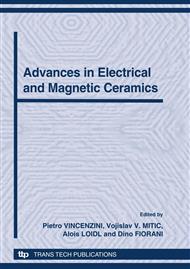p.42
p.49
p.59
p.64
p.74
p.82
p.92
p.98
p.104
Magnetostrictive Galfenol Torque Sensor Devices for Smart by-Wire Steering System in Automobile Technology
Abstract:
Polycrystalline Galfenol (Fe-Ga-X, X=Al, C, Zr etc.) alloys were fabricated as a bulk sample from rapid-solidified powders or ark-melted and annealing process method for enhancing various engineering applicabilities of this magnetostrictive alloy. Especially, (Fe-Ga0.15-Al0.05)99.0-Zr0.5-C0.5 [at.%] sample showed a maximum magnetostriction of λmax=90ppm to 150ppm as well as a tensile stress over σ=800MPa. This large magnetostriction is mainly caused by non-precipitating of the ordered A2 phases without the excessive precipitation of ordered phases such as fcc ordered L12, bcc ordered D03 phases and the remained [100] oriented strong textures by a heat treatment. Based on the improvements of these properties in the developed bulk Galfenol alloys, secondarily, we will introduce an application as a smart torque sensor by utilizing Galfenol-ring around the shaft for steering-by-wire system of automobile. A torque sensing system by using the magnetostrictive ring of Galfenol alloy was developed and magnetic flux leakage from the ring attached on the rotating shaft was experimentally measured by using differential Hall probe sensor. The sensitivity of this type of torque-sensor shows a strong dependency of metallurgical microstructure and the residual stress (i.e.hoop-stress) in the ring due to sensor shows a strong dependency of the residual stress (i.e.hoop-stress) in the ring due to the fitting level. A promising result on ring-type and single-structured inverse magnetostrictive torque sensor will be presented.
Info:
Periodical:
Pages:
74-81
Citation:
Online since:
October 2010
Authors:
Price:
Сopyright:
© 2010 Trans Tech Publications Ltd. All Rights Reserved
Share:
Citation:


